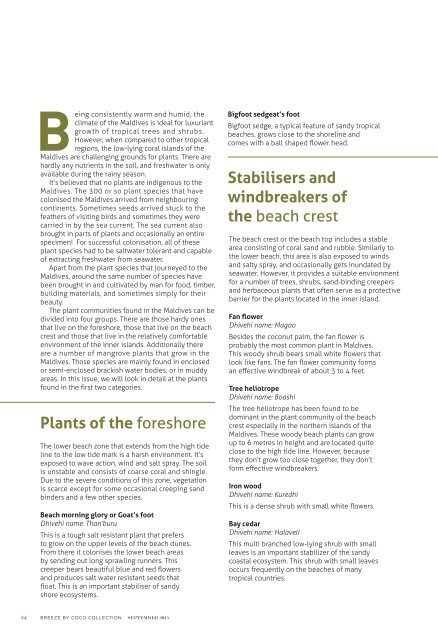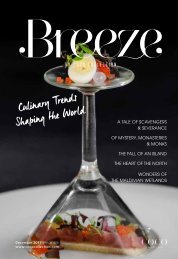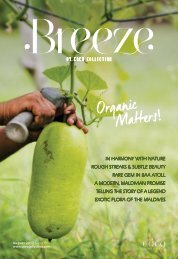You also want an ePaper? Increase the reach of your titles
YUMPU automatically turns print PDFs into web optimized ePapers that Google loves.
Being consistently warm and humid, the<br />
climate of the Maldives is ideal for luxuriant<br />
growth of tropical trees and shrubs.<br />
However, when compared to other tropical<br />
regions, the low-lying coral islands of the<br />
Maldives are challenging grounds for plants. There are<br />
hardly any nutrients in the soil, and freshwater is only<br />
available during the rainy season.<br />
It’s believed that no plants are indigenous to the<br />
Maldives. The 300 or so plant species that have<br />
colonised the Maldives arrived from neighbouring<br />
continents. Sometimes seeds arrived stuck to the<br />
feathers of visiting birds and sometimes they were<br />
carried in by the sea current. The sea current also<br />
brought in parts of plants and occasionally an entire<br />
specimen! For successful colonisation, all of these<br />
plant species had to be saltwater tolerant and capable<br />
of extracting freshwater from seawater.<br />
Apart from the plant species that journeyed to the<br />
Maldives, around the same number of species have<br />
been brought in and cultivated by man for food, timber,<br />
building materials, and sometimes simply for their<br />
beauty.<br />
The plant communities found in the Maldives can be<br />
divided into four groups. There are those hardy ones<br />
that live on the foreshore, those that live on the beach<br />
crest and those that live in the relatively comfortable<br />
environment of the inner islands. Additionally there<br />
are a number of mangrove plants that grow in the<br />
Maldives. Those species are mainly found in enclosed<br />
or semi-enclosed brackish water bodies, or in muddy<br />
areas. In this issue, we will look in detail at the plants<br />
found in the first two categories.<br />
Plants of the foreshore<br />
The lower beach zone that extends from the high tide<br />
line to the low tide mark is a harsh environment. It’s<br />
exposed to wave action, wind and salt spray. The soil<br />
is unstable and consists of coarse coral and shingle.<br />
Due to the severe conditions of this zone, vegetation<br />
is scarce except for some occasional creeping sand<br />
binders and a few other species.<br />
Beach morning glory or Goat’s foot<br />
Dhivehi name: Than’buru<br />
This is a tough salt resistant plant that prefers<br />
to grow on the upper levels of the beach dunes.<br />
From there it colonises the lower beach areas<br />
by sending out long sprawling runners. This<br />
creeper bears beautiful blue and red flowers<br />
and produces salt water resistant seeds that<br />
float. This is an important stabiliser of sandy<br />
shore ecosystems.<br />
Bigfoot sedgeat’s foot<br />
Bigfoot sedge, a typical feature of sandy tropical<br />
beaches, grows close to the shoreline and<br />
comes with a ball shaped flower head.<br />
Stabilisers and<br />
windbreakers of<br />
the beach crest<br />
The beach crest or the beach top includes a stable<br />
area consisting of coral sand and rubble. Similarly to<br />
the lower beach, this area is also exposed to winds<br />
and salty spray, and occasionally gets inundated by<br />
seawater. However, it provides a suitable environment<br />
for a number of trees, shrubs, sand-binding creepers<br />
and herbaceous plants that often serve as a protective<br />
barrier for the plants located in the inner island.<br />
Fan flower<br />
Dhivehi name: Magoo<br />
Besides the coconut palm, the fan flower is<br />
probably the most common plant in Maldives.<br />
This woody shrub bears small white flowers that<br />
look like fans. The fan flower community forms<br />
an effective windbreak of about 3 to 4 feet.<br />
Tree heliotrope<br />
Dhivehi name: Boashi<br />
The tree heliotrope has been found to be<br />
dominant in the plant community of the beach<br />
crest especially in the northern islands of the<br />
Maldives. These woody beach plants can grow<br />
up to 6 metres in height and are located quite<br />
close to the high tide line. However, because<br />
they don’t grow too close together, they don’t<br />
form effective windbreakers.<br />
Iron wood<br />
Dhivehi name: Kuredhi<br />
This is a dense shrub with small white flowers.<br />
Bay cedar<br />
Dhivehi name: Halaveli<br />
This multi branched low-lying shrub with small<br />
leaves is an important stabilizer of the sandy<br />
coastal ecosystem. This shrub with small leaves<br />
occurs frequently on the beaches of many<br />
tropical countries.<br />
44 BREEZE BY COCO COLLECTION SEPTEMBER 2015














